Listen Bible Reading Day 1 Britto Augustus
| Saint Ignatius of Loyola S.J. | |
|---|---|
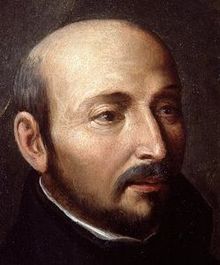 Ignatius of Loyola, anonymous 16th-c. | |
| Priest, Confessor, Founder of the Society of Jesus | |
| Born | Iñigo López de Oñaz y Loyola (1491-ten-23)23 October 1491 Azpeitia, Gipuzkoa, Crown of Castile (today Espana) |
| Died | 31 July 1556(1556-07-31) (aged 64) Rome, Papal States |
| Venerated in |
|
| Beatified | 27 July 1609, Rome, Papal States by Pope Paul V |
| Canonized | 12 March 1622, Rome, Papal States past Pope Gregory XV |
| Feast | 31 July |
| Attributes | Sacerdotal vestments, cassock, ferraiolo, biretta, holding a volume with "Advert maiorem Dei gloriam" inscription, trampling on a heretic, IHS Christogram, crucifix, and a rosary |
| Patronage |
|
| Major works | Ignatian spirituality |
Ignatius of Loyola, S.J. (born Iñigo López de Oñaz y Loyola; Basque: Ignazio Loiolakoa; Spanish: Ignacio de Loyola; Latin: Ignatius de Loyola; c. 23 October 1491 [2] – 31 July 1556), venerated every bit Saint Ignatius of Loyola, was a Spanish Catholic priest and theologian, who, with Peter Faber and Francis Xavier, founded the religious guild of the Society of Jesus (The Jesuits), and became the first Superior General of the Social club of Jesus, in Paris, in 1541.[3] He envisioned the purpose of the Society of Jesus to be missionary work and teaching. Dissimilar members of other religious orders in the church who have the vows of guiltlessness, obedience and poverty, members of the club, Jesuits, also take a fourth vow of obedience to the Pope, to appoint in projects ordained by the pontiff.[4] Jesuits were instrumental in leading the accuse of the Counter-Reformation.[5]
Equally a former soldier, Ignatius paid particular attention to the spiritual formation of his recruits and recorded his method in the Spiritual Exercises (1548). In time, the method has become known as Ignatian spirituality.
Ignatius of Loyola was beatified in 1609 and canonized saint, on 12 March 1622. His feast day is celebrated on 31 July. He is the patron saint of the Basque provinces of Gipuzkoa and Biscay as well as of the Society of Jesus. He was declared patron saint of all spiritual retreats by Pope Pius XI in 1922.
Early life [edit]
Ignatius of Loyola was born Íñigo López de Loyola in the castle at Loyola, in the municipality of Azpeitia, Gipuzkoa, in the Basque Land of Spain.[half dozen] His parents, Don Beltrán and Doña Marina, were of the minor dignity,[seven] from the clan of Loyola, involved in the Basque war of the bands. Their manor firm was demolished on the orders of the King of Castile in 1456 for their depredations in Gipuzkoa, with Iñigo'due south paternal grandpa existence expelled to Andalusia by Henry IV.[8] Íñigo was the youngest of their thirteen children. Their eldest son, Juan Pérez, had soldiered in forces commanded by Gonzalo Fernández de Córdoba, simply died fighting in the Italian Wars (1494–1559).[nine]
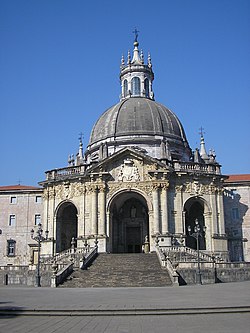
He was baptized "Íñigo" on honor of Íñigo of Oña, Abbot of Oña; the proper name too is a medieval Basque diminutive for "My little one".[6] [10] It is non clear when he began using the Latin proper noun "Ignatius" instead of his baptismal name "Íñigo".[11] Historian Gabriel María Verd says that Íñigo did not intend to modify his name, just rather adopted a proper name which he believed was a simple variant of his own, for utilise in France and Italia where information technology was better understood.[12] Íñigo adopted the surname "de Loyola" in reference to the Basque village of Loyola where he was born.[13]
Because doña Marina died soon later the nascence of Íñigo, his maternal intendance fell to María de Garín, the wife of the local blacksmith.[fourteen] In 1498, his second eldest brother, Martin, heir to the estate, took his new married woman to live in the castle, and she became mistress of the household. Subsequently, the seven-year-old boy Íñigo returned to Casa Loyola. Anticipating his possible ecclesiastic career, Don Beltrán had Íñigo's hair cut as a tonsure.[9]
Armed forces career [edit]

Ignatius in his armour, in a 16th-century painting

Saint Ignatius of Loyola's Vision of Christ and God the Father at La Storta past Domenichino[15]
Instead, Íñigo became a page in the service of a relative, Juan Velázquez de Cuéllar, treasurer (contador mayor) of the kingdom of Castile. During his time in the household of Don Velázquez, Íñigo took up dancing, fencing, gambling, the pursuit of the young ladies, and duelling.[ix] Íñigo was neat on military exercises and was driven by a desire for fame. He framed his life around the stories of El Cid, the knights of Camelot, The Vocal of Roland and other tales of romantic chivalry.[16]
He joined the army at seventeen, and according to one biographer, he strutted nearly "with his cape flight open to reveal his tight-fitting hose and boots; a sword and dagger at his waist".[17] [ page needed ] According to another he was "a fancy dresser, an skillful dancer, a womanizer, sensitive to insult, and a rough punkish swordsman who used his privileged condition to escape prosecution for tearing crimes committed with his priest blood brother at funfair time."[18]
In 1509, anile 18, Íñigo took up artillery for Antonio Manrique de Lara, 2d Duke of Nájera. His diplomacy and leadership qualities earned him the championship "servant of the courtroom", and made him very useful to the Duke.[xix] Under the Duke's leadership, Íñigo participated in many battles without injury. However at the Battle of Pamplona on 20 May 1521 he was gravely injured when a French-Navarrese expedition force stormed the fortress of Pamplona, and a cannonball ricocheting off a nearby wall shattered his right leg.[20] Íñigo was returned to his father's castle in Loyola, where, in an era before anesthetics, he underwent several surgical operations to repair the leg, with his bones set and rebroken. In the end, the operations left his right leg shorter than the other. He would limp for the residue of his life, with his armed services career over.[eighteen]
Religious conversion and visions [edit]
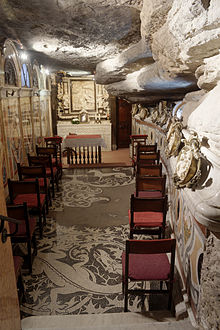
While recovering from surgery, Íñigo underwent a spiritual conversion and discerned a telephone call to the religious life. In guild to divert the weary hours of convalescence, he asked for the romances of knightly, his favourite reading, but there were none in the castle, and instead his beloved sister-in-constabulary, Magdalena de Araoz brought him the lives of Christ and of the saints.[six] [21]
The religious work which most peculiarly struck him was the De Vita Christi of Ludolph of Saxony.[22] This book would influence his whole life, inspiring him to devote himself to God and follow the instance of Francis of Assisi and other slap-up monks. It also inspired his method of meditation, since Ludolph proposes that the reader place himself mentally at the scene of the Gospel story, visualising the crib at the Birth, etc. This type of meditation, known as Simple Contemplation, was the ground for the method that Ignatius outlined in his Spiritual Exercises.[23] [24] [25]
Aside from dreaming nigh imitating the saints in his readings, Íñigo was still wandering off in his mind virtually what "he would do in service to his king and in laurels of the majestic lady he was in love with". Charily he came to realize the later-event of both kinds of his dreams. He experienced pathos and dissatisfaction when the romantic heroism dream was over, but, the saintly dream ended with much joy and peace. It was the first time he learned most discernment.[18]
Afterwards he had recovered sufficiently to walk again, Íñigo resolved to brainstorm a pilgrimage to the Holy State to "osculation the earth where our Lord had walked",[18] and to practice stricter penances.[26] He thought that his programme was confirmed by a vision of the Virgin Mary and the infant Jesus he experienced 1 night, which resulted in much consolation to him.[26] In March 1522, he visited the Benedictine monastery of Santa Maria de Montserrat. There, he carefully examined his by sins, confessed, gave his fine clothes to the poor he met, wore a "garment of sack-cloth", and so hung his sword and dagger at the Virgin'south altar during an overnight vigil at the shrine.[6]
From Montserrat he walked on to the nearby town of Manresa (Catalonia), where he lived for about a year, begging for his go along, and then eventually doing chores at a local infirmary in exchange for food and lodging. For several months he spent much of his time praying in a cave nearby where he practised rigorous asceticism, praying for seven hours a day, and formulating the fundamentals of his Spiritual Exercises.[27]
Íñigo besides experienced a series of visions in full daylight while at the hospital. These repeated visions appeared as "a form in the air near him and this class gave him much consolation because it was exceedingly beautiful ... information technology somehow seemed to accept the shape of a snake and had many things that shone like eyes, simply were not eyes. He received much delight and consolation from gazing upon this object ... but when the object vanished he became disconsolate".[28] He came to interpret this vision as diabolical in nature.[29]
Period of studies [edit]
In September 1523, Íñigo fabricated a pilgrimage to the Holy Land with the aim of settling there. He remained there from 3 to 23 September but was sent back to Europe past the Franciscans.[xxx]
He returned to Barcelona and at the age of thirty-three attended a free public grammar school in preparation for university entrance. He went on to the University of Alcalá,[31] where he studied theology and Latin from 1524 to 1534.[ citation needed ]
In that location he encountered a number of devout women who had been chosen earlier the Inquisition. These women were considered alumbrados – a group linked in their zeal and spirituality to Franciscan reforms, but they had incurred mounting suspicion from the administrators of the Inquisition. Once when Íñigo was preaching on the street, three of these devout women began to experience ecstatic states. "I fell senseless, some other sometimes rolled about on the ground, another had been seen in the grip of convulsions or shuddering and sweating in anguish." The suspicious activity took place while Íñigo had preached without a degree in theology. As a issue, he was singled out for interrogation by the Inquisition, but was after released.[32]
Following these risky activities, Íñigo (past this time, he had changed his name to Ignatius, probably to make information technology more than acceptable to other Europeans) [12] adopted the surname "de Loyola" in reference to the Basque village of Loyola where he was born.[13] moved to France to written report at the University of Paris. He attended showtime the austere Collège de Montaigu, moving on to the Collège Sainte-Barbe to study for a master's degree.[33]
He arrived in French republic at a fourth dimension of anti-Protestant turmoil which had forced John Calvin to abscond France. Very before long after, Ignatius had gathered around him six companions, all of them fellow students at the university.[34] They were the Spaniards Alfonso Salmeron, Diego Laynez, and Nicholas Bobadilla, with the Portuguese Simão Rodrigues, the Basque, Francis Xavier, and Peter Faber, a Savoyard, the latter ii becoming his outset companions,[18] and his closest assembly in the foundation of the hereafter Jesuit order.[ citation needed ]
"On the morning of the 15th of August, 1534, in the chapel of church of Saint Peter, at Montmartre, Loyola and his six companions, of whom simply one was a priest, met and took upon themselves the solemn vows of their lifelong piece of work."[35]
Ignatius gained a Magisterium from the University of Paris at the age of twoscore-three in 1535. In later life he would often be called "Principal Ignatius" because of this.[35]
Foundation of the Jesuit order [edit]
In 1539, with Peter Faber and Francis Xavier, Ignatius formed the Social club of Jesus, which was approved in 1540 by Pope Paul III. He was chosen as the first Superior General of the society and invested with the title of "Father General" by the Jesuits.[13]
Ignatius sent his companions on missions beyond Europe to create schools, colleges, and seminaries. Juan de Vega, so ambassador of Charles Five, Holy Roman Emperor in Rome, met Ignatius there and having formed a expert impression of the Jesuits, invited them to travel with him to his new date every bit Viceroy of Sicily. Every bit a issue, a Jesuit college was opened in Messina, which proved a success, so that its rules and methods were later copied in subsequent colleges.[36] In a letter to Francis Xavier before his departure to Bharat in 1541, Ignatius famously used the Latin phrase "Ite, inflammate omnia", meaning, "Become, set the earth on burn", a phrase used in the Jesuit gild to this solar day.[37]
With the assistance of his personal secretary, Juan Alfonso de Polanco, Ignatius wrote the Jesuit Constitutions, which were adopted in 1553. They created a centralised system of the order,[38] [39] and stressed absolute self-denial and obedience to the Pope and to superiors in the Church hierarchy. This was summarised in the motto perinde air-conditioning cadaver – "every bit if a dead body",[twoscore] meaning that a Jesuit should be as emptied of ego as is a corpse.[41] However the overarching Jesuit principle became: Ad maiorem Dei gloriam ("for the greater glory of God").[ citation needed ]
-

Ignatius every bit Superior General
Decease and canonization [edit]
Ignatius died in Rome on 31 July 1556, probably of the "Roman Fever", a severe variant of malaria which was endemic in Rome throughout medieval history. An autopsy revealed that he also had kidney and float stones, a probable cause of the abdominal pains he suffered from in later life.[42] [ folio needed ] His body was dressed in his priestly robes and placed in a wooden coffin and buried in the crypt of the Maria della Strada Church on 1 August 1556. In 1568 the church building was demolished and replaced with the Church building of the Gesù. Ignatius' remains were reinterred in the new church in a new coffin.[43]
Ignatius was beatified by Pope Paul 5 on 27 July 1609, and canonized past Pope Gregory Fifteen on 12 March 1622.[44] His feast day is celebrated annually on 31 July, the day he died. He is venerated as the patron saint of Catholic soldiers, the Military Ordinariate of the Philippines, the Roman Catholic Archdiocese of Baltimore,[45] in his native Basque State, the Roman Catholic Diocese of Antwerp, Belo Horizonte, Junín, and Rome.
Legacy [edit]
Numerous institutions beyond the world are named for him, including many educational institutions and Ateneo institutions in the Philippines.
In 1852, Loyola Academy Maryland was the first university in the United states of america to bear his name.
In 1949 he was the subject of a Spanish biographical film Loyola, the Soldier Saint starring Rafael Durán in the role of Ignatius.[ citation needed ]
In 2016, he was the subject of a Filipino movie, Ignacio de Loyola, in which he was portrayed past Andreas Muñoz.[46]
Ignatius of Loyola is remembered in the Church of England with a commemoration on 31 July.[47]
Genealogy [edit]

Original shield of Oñaz-Loyola.
Shield of Oñaz-Loyola [edit]
The Shield of Oñaz-Loyola is a symbol of Ignatius family's Oñaz lineage, and is used by many Jesuit institutions around the world. Equally the official colours of the Loyola family unit are maroon and aureate,[48] the Oñaz shield consists of seven maroon confined going diagonally from the upper left to the lower right on a goldfield. The bands were granted by the King of Spain to each of the Oñaz brothers, in recognition of their bravery in battle. The Loyola shield features a pair of rampant gray wolves flanking each side of a cooking pot. The wolf was a symbol of nobility, while the unabridged design represented the family'south generosity towards their war machine followers. Co-ordinate to legend, wolves had plenty to feast on afterward the soldiers had eaten. Both shields were combined equally a result of the intermarriage of the two families in 1261.[49] [50] Erstwhile coat of arms of the Argentine metropolis, Junín, Buenos Aires used until 1941 bore Loyola shield nether the Dominicus of May and surrounded past laurel wreath.
Lineage [edit]
Villoslada established the following detailed genealogy of Ignatius of Loyola:[2]
| Lineage | |||||||||||||||||||||||||||||||||||||||||||||||||||||||||||||||||||||||||||||||||||||||||||||||||||||||||||||||||||||||||||||||||||||||||||||||||||||||||||||||||||||||||||||||||||||||||||||||||||||||||||||||||||||||||||||||||||||||||||||||||||||||||||||||||||||||||||||||||||||||||||||||||||||||||||||||||||||||||||||||||||||||||||||||||||||||||||||||||||||||||||||||||||||||||||||||||||||||||||||||||||||||||||||||||||||||||||||||||||||||||||||||||||||||||||||||||||||||||||||||||||||||||||||||||||||||||||||||||||||||||||||||||||||||||||||||||||||||||||||||||||||||||||||||||||||||||||||||||||||||||||||||||||||||||||||||||||||||||||||||||||||||||||||||||||||||||||||||||||||||||||||||||||||||||||||||||||||||||||||||||||||||||||||||||||||||||||||||||||||||||||||||||||||||||||||||||||||||||||||||||||
|---|---|---|---|---|---|---|---|---|---|---|---|---|---|---|---|---|---|---|---|---|---|---|---|---|---|---|---|---|---|---|---|---|---|---|---|---|---|---|---|---|---|---|---|---|---|---|---|---|---|---|---|---|---|---|---|---|---|---|---|---|---|---|---|---|---|---|---|---|---|---|---|---|---|---|---|---|---|---|---|---|---|---|---|---|---|---|---|---|---|---|---|---|---|---|---|---|---|---|---|---|---|---|---|---|---|---|---|---|---|---|---|---|---|---|---|---|---|---|---|---|---|---|---|---|---|---|---|---|---|---|---|---|---|---|---|---|---|---|---|---|---|---|---|---|---|---|---|---|---|---|---|---|---|---|---|---|---|---|---|---|---|---|---|---|---|---|---|---|---|---|---|---|---|---|---|---|---|---|---|---|---|---|---|---|---|---|---|---|---|---|---|---|---|---|---|---|---|---|---|---|---|---|---|---|---|---|---|---|---|---|---|---|---|---|---|---|---|---|---|---|---|---|---|---|---|---|---|---|---|---|---|---|---|---|---|---|---|---|---|---|---|---|---|---|---|---|---|---|---|---|---|---|---|---|---|---|---|---|---|---|---|---|---|---|---|---|---|---|---|---|---|---|---|---|---|---|---|---|---|---|---|---|---|---|---|---|---|---|---|---|---|---|---|---|---|---|---|---|---|---|---|---|---|---|---|---|---|---|---|---|---|---|---|---|---|---|---|---|---|---|---|---|---|---|---|---|---|---|---|---|---|---|---|---|---|---|---|---|---|---|---|---|---|---|---|---|---|---|---|---|---|---|---|---|---|---|---|---|---|---|---|---|---|---|---|---|---|---|---|---|---|---|---|---|---|---|---|---|---|---|---|---|---|---|---|---|---|---|---|---|---|---|---|---|---|---|---|---|---|---|---|---|---|---|---|---|---|---|---|---|---|---|---|---|---|---|---|---|---|---|---|---|---|---|---|---|---|---|---|---|---|---|---|---|---|---|---|---|---|---|---|---|---|---|---|---|---|---|---|---|---|---|---|---|---|---|---|---|---|---|---|---|---|---|---|---|---|---|---|---|---|---|---|---|---|---|---|---|---|---|---|---|---|---|---|---|---|---|---|---|---|---|---|---|---|---|---|---|---|---|---|---|---|---|---|---|---|---|---|---|---|---|---|---|---|---|---|---|---|---|---|---|---|---|---|---|---|---|---|---|---|---|---|---|---|---|---|---|---|---|---|---|---|---|---|---|---|---|---|---|---|---|---|---|---|---|---|---|---|---|---|---|---|---|---|---|---|---|---|---|---|---|---|---|---|---|---|---|---|---|---|---|---|---|---|---|---|---|---|---|---|---|---|---|---|---|---|---|---|---|---|---|---|---|---|---|---|---|---|---|---|---|---|---|---|---|---|---|---|---|---|---|---|---|---|---|---|---|---|---|---|---|---|---|---|---|---|---|---|---|---|---|---|---|---|---|---|---|---|---|---|---|---|---|---|---|---|---|---|---|---|---|---|---|---|---|---|---|---|---|---|---|---|---|---|---|---|---|---|---|---|---|---|---|---|---|---|---|---|---|---|---|---|---|---|---|---|---|---|---|---|---|---|---|---|---|---|---|---|---|---|---|---|---|---|---|---|---|---|---|---|---|---|---|---|---|---|---|---|---|---|---|---|---|---|---|---|---|---|---|---|---|---|---|---|---|---|---|---|---|---|---|---|---|---|---|---|---|---|---|---|---|---|---|---|---|---|---|---|---|---|---|---|---|---|---|---|---|---|---|---|---|---|---|---|---|---|---|---|---|---|---|---|---|---|---|---|---|---|---|---|---|---|
| |||||||||||||||||||||||||||||||||||||||||||||||||||||||||||||||||||||||||||||||||||||||||||||||||||||||||||||||||||||||||||||||||||||||||||||||||||||||||||||||||||||||||||||||||||||||||||||||||||||||||||||||||||||||||||||||||||||||||||||||||||||||||||||||||||||||||||||||||||||||||||||||||||||||||||||||||||||||||||||||||||||||||||||||||||||||||||||||||||||||||||||||||||||||||||||||||||||||||||||||||||||||||||||||||||||||||||||||||||||||||||||||||||||||||||||||||||||||||||||||||||||||||||||||||||||||||||||||||||||||||||||||||||||||||||||||||||||||||||||||||||||||||||||||||||||||||||||||||||||||||||||||||||||||||||||||||||||||||||||||||||||||||||||||||||||||||||||||||||||||||||||||||||||||||||||||||||||||||||||||||||||||||||||||||||||||||||||||||||||||||||||||||||||||||||||||||||||||||||||||||||
| Notes: | |||||||||||||||||||||||||||||||||||||||||||||||||||||||||||||||||||||||||||||||||||||||||||||||||||||||||||||||||||||||||||||||||||||||||||||||||||||||||||||||||||||||||||||||||||||||||||||||||||||||||||||||||||||||||||||||||||||||||||||||||||||||||||||||||||||||||||||||||||||||||||||||||||||||||||||||||||||||||||||||||||||||||||||||||||||||||||||||||||||||||||||||||||||||||||||||||||||||||||||||||||||||||||||||||||||||||||||||||||||||||||||||||||||||||||||||||||||||||||||||||||||||||||||||||||||||||||||||||||||||||||||||||||||||||||||||||||||||||||||||||||||||||||||||||||||||||||||||||||||||||||||||||||||||||||||||||||||||||||||||||||||||||||||||||||||||||||||||||||||||||||||||||||||||||||||||||||||||||||||||||||||||||||||||||||||||||||||||||||||||||||||||||||||||||||||||||||||||||||||||||||
Martín García Óñez de Loyola, soldier and Governor of Chile killed past Mapuches at the Boxing of Curalaba, is probable Ignatius'south nephew.[51]
Gallery [edit]
-
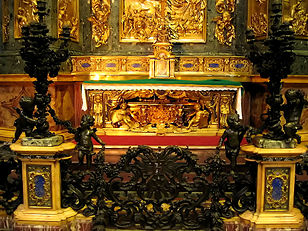
Tomb of Saint Ignatius, c. 1675
-
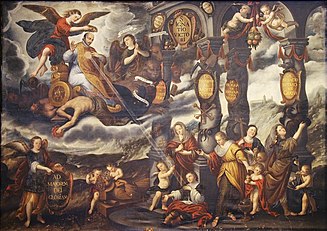
Apotheosis of Saint Ignatius
-

-

The journeys of Ignatius of Loyola at different times
-

Bibliography [edit]
- The Spiritual Exercises of St Ignatius, TAN Books, 2010. ISBN 978-0-89555-153-v
- Ignatius of Loyola, Spiritual Exercises, London, 2012. limovia.internet ISBN 978-1-78336-012-3
- Loyola, (St.) Ignatius (1964). The Spiritual Exercises of St. Ignatius. Anthony Mottola. Garden City: Doubleday. ISBN978-0-385-02436-five.
- Loyola, (St.) Ignatius (1900). Joseph O'Conner (ed.). The Autobiography of St. Ignatius. New York: Benziger Brothers. OCLC 1360267. For data on the O'Conner and other translations, meet notes in A Pilgrim's Journey: The Autobiography of Ignatius of Loyola Page xi-12.
- Loyola, (St.) Ignatius (1992). John Olin (ed.). The Autobiography of St. Ignatius Loyola, with Related Documents. New York: Fordham Academy Press. ISBN0-8232-1480-Ten.
Come across also [edit]
- List of Jesuits
- Marie-Madeleine d'Houët foundress of the Sisters, True-blue Companions of Jesus
- Martín Ignacio de Loyola
- The Cave of Saint Ignatius, a sanctuary built where Ignatius of Loyola reflected for 11 months in a grotto, in Manresa.
- Isabella Roser and Isabel de Josa, wealthy Catalan women who were Loyola'south benefactors from the 1520s onwards.
References [edit]
- ^ "Holy Men and Holy Women" (PDF). Churchofengland.org.
- ^ a b García Villoslada, Ricardo (1986). San Ignacio de Loyola: Nueva biografía (in Spanish). La Editorial Católica. ISBN84-220-1267-vii.
We deduce that, (...), Iñigo de Loyola should have been born earlier 23 October 1491.
- ^ Idígoras Tellechea, José Ignacio (1994). "When was he born? His nurse'southward account". Ignatius of Loyola: The Pilgrim Saint . Chicago: Loyola University Printing. p. 45. ISBN0-8294-0779-0.
- ^ Ignatius of Loyola (1970). The Constitutions of the Society of Jesus. Translated by Ganss, George East. Found of Jesuit Sources. p. 249 [No. 529]. ISBN9780912422206.
The entire meaning of this quaternary vow of obedience to the pope was and is in regard to the missions ... this obedience is treated: in everything which the sovereign pontiff commands.
- ^ Nugent, Donald (1974). Ecumenism in the Age of the Reformation: The Colloquy of Poissy. Harvard Academy Press. p. 189. ISBN0-674-23725-0.
- ^ a b c d John Hungerford Pollen (1913). "St. Ignatius Loyola". In Herbermann, Charles (ed.). Catholic Encyclopedia. New York: Robert Appleton Company. Retrieved 28 June 2008.
- ^ Purcell, Mary (1965). The First Jesuit. United states of america: Image Books edition. p. 22.
- ^ Orella, Jose Luis (2013). "TERRITORIO Y SOCIEDAD EN LA GIPUZKOA MEDIEVAL: LOS PARIENTES MAYORES" (PDF). Lurralde: investigación y espacio. 36: 100–101. ISSN 0211-5891.
- ^ a b c Brodrick SJ, James. Saint Ignatius Loyola: The Pilgrim Years, New York. Farrar, Straus and Cudahy, 1956, p. 28
- ^ "Nombres: Eneko". Euskaltzaindia (The Royal Academy of the Basque Linguistic communication). Archived from the original on 10 Nov 2013. Retrieved 23 April 2009. Article in Spanish
- ^ Verd, Gabriel María (1976). "El "Íñigo" de San Ignacio de Loyola". Archivum Historicum Societatis Iesu (in Spanish). Roma: Institutum Historicum Societatis Iesu. 45: 95–128. ISSN 0037-8887.
- ^ a b Verd, Gabriel María (1991). "De Iñigo a Ignacio. El cambio de nombre en San Ignacio de Loyola". Archivum Historicum Societatis Iesu (in Spanish). Roma: Institutum Historicum Societatis Iesu. sixty: 113–160. ISSN 0037-8887.
That St. Ignatius of Loyola's name was changed is a known fact, but it cannot exist said that it is widely known in the historiography of the saint — neither the characteristics of the names Iñigo and Ignacio nor the reasons for the modify. Information technology is starting time necessary to make clear the meaning of the names; they are distinct, despite the persistently held stance in onomastic (dictionaries) and popular thought. In Kingdom of spain Ignacio and Iñigo are at times used interchangeably merely as if they were Jacobo and Jaime. With reference to the name Iñigo, it is fitting to requite some essential notions to eliminate ambiguities and help empathize what follows. This name first appears on the Ascoli brome (dated Nov 18, 90 BC), in a list of Castilian knights belonging to a Turma salluitana or Saragossan. It speaks of Elandus Enneces f[ilius], and according to Menéndez Pidal, the final «s» is the «z» of Spanish patronymics and could be zero other than Elando Iñiguez. Information technology is an ancestral Hispanic name. Ignacio, on the other manus, is a Latin name. In classical Latin, at that place is Egnatius with an initial E. It appears just twice with an initial I (Ignatius) in the sixty volumes of the Corpus Inscriptionum Latinarum. This tardily Latin and Greek form prevailed. In the classical flow, Egnatius was used as a nomen (gentilitial proper name) and non as a praenomen (get-go proper name) or cognomen (surname), except in very rare cases. (...) The virtually important conclusion, perhaps unexpected, but not unknown, is that St. Ignatius did non change his name. That is to say, he did not intend to modify it. What he did was to adopt for France and Italy a proper noun which he believed was a simple variant of his own, and which was more adequate among foreigners.... If he had remained in Kingdom of spain, he would have, without doubt, remained Iñigo.
- ^ a b c "Saint Ignatius of Loyola: Biography, Patron Saint Of, Feast Day, & Facts". Encyclopedia Britannica . Retrieved 20 June 2021.
- ^ Ignatius of Loyola: The Psychology of a Saint; West.W Meissner S.J. M.D., Yale University Press, 1992. p. 9.
- ^ "Saint Ignatius of Loyola's Vision of Christ and God the Father at La Storta". lacma.org. Los Angeles County Museum of Art (LACMA). 30 November 2016.
- ^ Ironically, the Song of Roland has Roland slain by Moors, when historically his expiry was at the hands of Basques like Íñigo himself.
- ^ Richard Cohen (5 August 2003). Past the Sword: A History of Gladiators, Musketeers, Samurai, Swashbucklers, and Olympic Champions. Mod Library Paperbacks.
- ^ a b c d e "Traub, South.J., George and Mooney, Ph.D., Debra. A Biography of St. Ignatius Loyola, Xavier Academy". Archived from the original on 28 Baronial 2017. Retrieved xiv October 2016.
- ^ In Spanish the championship was "Gentilhombre", but this should not be understood as synonymous with the English term admirer, which denotes a man of expert family. Meet Thomas Rochford, title=St. Ignatius Loyola: the pilgrim and man of prayer who founded the Society of Jesus "St. Ignatius Loyola: the pilgrim and man of prayer who founded the Society of Jesus", accessed 15 November 2007.]
- ^ Mariani, Antonio. "The Life of St. Ignatius Loyola, Founder of the Jesuits". Thomas Richardson. Retrieved i June 2019.
- ^ Dyckman, Katherine; Garvin; Liebert (2001). The Spiritual Exercises Reclaimed: Uncovering Liberating Possibilities for Women. Mahwah, New Jersey: Paulist Printing. p. xxx. ISBN9780809140435.
- ^ De Vita Christi is a commentary on the Gospels, using extracts from the works of over threescore Church building Fathers, and especially quoting from St Gregory the Neat, St Basil, St Augustine and the Venerable Bede. This piece of work took Ludolph twoscore years to complete.
- ^ Sr Mary Immaculate Bodenstedt, "The Vita Christi of Ludolphus the Carthusian", a Dissertation, Washington: Catholic Academy of America Press 1944 British Library Catalogue No. Ac2692.y/29.(16).
- ^ "The Vita Christi" past Charles Abbot Conway Analecta Cartusiana 34
- ^ "Ludolph'south Life of Christ" by Father Henry James Coleridge in The Calendar month Vol. 17 (New Series Half dozen) July–December 1872, pp. 337–370
- ^ a b Margo J. Heydt; Sarah J. Melcher (May 2008). "Mary, the Hidden Catalyst: Reflections from an Ignatian Pilgrimage to Espana and Rome". Xavier University. Archived from the original on 30 August 2017.
- ^ "The Cavern an artistic heritage". The Cave. Identify of pilgrimage and worship . Retrieved 4 August 2014.
- ^ Jean Lacouture, Jesuits, A Multibiography, Washington, D.C.: Counterpoint, 1995, p. 18.
- ^ Demski, Eric (2014). Living by the Sword. Bloomington, Indiana: Trafford Publishing. p. 289. ISBN978-1-490-73607-5.
- ^ Twelve years subsequently, standing earlier the Pope with his companions, Ignatius again proposed sending his companions as emissaries to Jerusalem. Jean Lacouture, Jesuits, A Multibiography, Washington, D.C.: Counterpoint, 1995, p. 24.
- ^ That is, the nowadays-twenty-four hour period Complutense University of Madrid, not the newer Academy of Alcalá established in 1977.
- ^ Jesuits, A Multibiography by Jean Lacouture, pp. 27–29, Washington, D.C.: Counterpoint, 1995.
- ^ O'Malley, John (1993). The Beginning Jesuits. Cambridge, Massachusetts: Harvard University Printing. p. 28-29.
- ^ Michael Servetus Research Archived eleven Oct 2014 at the Wayback Machine Website that includes graphical documents in the University of Paris of: Ignations of Loyola, Francis Xavier, Alfonso Salmerón, Nicholas Bobadilla, Peter Faber and Simao Rodrigues, likewise equally Michael de Villanueva ("Servetus")
- ^ a b History of The World by John Clarke Ridpath, Vol. V, pp. 238, New York: Merrill & Bakery, 1899
- ^ J.H. Pollen (1913). . In Herbermann, Charles (ed.). Cosmic Encyclopedia. New York: Robert Appleton Company.
- ^ Manney, James (ii May 2018). "Go Set the World on Burn down". Ignatian Spirituality . Retrieved 18 April 2021.
{{cite spider web}}: CS1 maint: url-status (link) - ^ Ignatius of Loyola (1970). The constitutions of the guild of Jesus. Translated past Ganss, George E. Institute of Jesuit Sources. p. 249. ISBN9780912422206.
Carried and directed past Divine Providence through the agency of the superior as if he were a lifeless body which allows itself to be carried to whatsoever place and to be treated in whatever fashion desired.
- ^ Painter, F. Five. N. (1903). A History of Instruction. International Education Series. Vol. two. New York: D. Appleton and Company. p. 167.
- ^ Jesuitas (1583). "SEXTA PARS – CAP. one". Constitutiones Societatis Iesu: cum earum declarationibus (in Latin).
- ^ Ignatius of Loyola (1970). The constitutions of the gild of Jesus. Translated by George E. Ganss. Found of Jesuit Sources. p. 249. ISBN9780912422206.
Carried and directed by Divine Providence through the agency of the superior as if he were a lifeless torso which allows itself to exist carried to any identify and to exist treated in whatever manner desired.
- ^ Siraisi, Nancy G. (2001). Medicine and the Italian Universities: 1250-1600. BRILL. ISBN9004119426.
- ^ Martin, Malachi (28 May 2013). Jesuits. Simon and Schuster. pp. 169–170. ISBN9781476751887 . Retrieved 11 March 2018.
- ^ de Pablo, José (28 February 2017). "Canonization of St Ignatius of Loyola and St Francis Xavier". Jesuit Conference of European Provincials . Retrieved ten March 2018.
- ^ "Welcome to the Archdiocese of Baltimore". Archdiocese of Baltimore. Archived from the original on x Baronial 2016. Retrieved 13 October 2012.
- ^ Tantiangco, Aya (20 July 2016). "PHL picture 'Ignacio de Loyola' not just for the religious, say managing director and star". GMA Network (company). Retrieved 28 July 2016.
- ^ "The Calendar". The Church of England . Retrieved 27 March 2021.
- ^ "Manresa Iconography – Manresa House of Retreats, Convent, LA". Archived from the original on 14 March 2013. Retrieved 13 October 2012.
- ^ "Loyola Crests – Loyola High School, Montreal, Quebec, Canada". Archived from the original on 21 October 2012. Retrieved 13 October 2012.
- ^ "Saint Ignatius' Higher Riverview". www.riverview.nsw.edu.au.
- ^ Barros Arana, Diego (2000) [1884]. Historia Full general de Chile (in Spanish). Vol. III (2 ed.). Santiago, Chile: Editorial Universitaria. p. 177. ISBN956-11-1535-2.
Farther reading [edit]
- Bartoli, Daniello (1855). History of the Life and Institute of St. Ignatius de Loyola: Founder of the Society of Jesus. New York: Edward Dunigan and Blood brother.
- Caraman, Philip (1990). Ignatius Loyola: A Biography of the Founder of the Jesuits' . San Francisco: Harper & Row. ISBN978-0062501301.
- August Derleth, St. Ignatius and the Visitor of Jesus, Vision Books, 1956. LCCN 56-7278
- Foss, Michael (1969). The Founding of the Jesuits, 1540. Turning Points in History Serial. London: Hamilton. ISBN0-241-01513-8.
- García Villoslada, Ricardo (1986). San Ignacio de Loyola: Nueva biografía (in Spanish). La Editorial Católica. ISBN84-220-1267-7.
- Meissner, William (1992). Ignatius of Loyola: The Psychology of a Saint . New Haven: Yale Academy Press. ISBN0-300-06079-3.
- O'Malley, John Due west. (1993). The Commencement Jesuits. Cambridge: Harvard University Press. ISBN0-674-30312-1.
- Life of St. Ignatius of Loyola, TAN Books, 1997. ISBN 978-0-89555-345-4.
- St. Ignatius of Loyola, TAN Books, 2008. ISBN 978-0-89555-624-0.
External links [edit]
- 3D model of the St Ignatius sculpture of Santa Clara University (California), on Arskan SiloData
- Works past Ignatius of Loyola at Projection Gutenberg
- Works by or about Ignatius of Loyola at Internet Archive
- Works by Ignatius of Loyola at LibriVox (public domain audiobooks)

- "St. Ignatius of Loyola, Confessor", Butler's Lives of the Saints
- The Spiritual Exercises of St. Ignatius Translation by Elderberry Mullan, S.J.
- Letters of Saint Ignatius of Loyola
- "Contemplation to Achieve Love", by Ignatius of Loyola
- Founder Statue in St Peter's Basilica
- Colonnade Statue St Peter's Square
- The Book of Spiritual Exercises of St. Ignatius Loyola, the Founder of the Jesuit Monastic Order in Arabic, dating from 1773
Source: https://en.wikipedia.org/wiki/Ignatius_of_Loyola
0 Response to "Listen Bible Reading Day 1 Britto Augustus"
Post a Comment